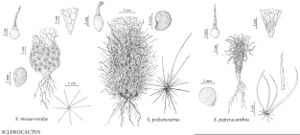Difference between revisions of "Sclerocactus papyracanthus"
Bradleya 5: 94. 1987.
FNA>Volume Importer |
FNA>Volume Importer |
Revision as of 22:23, 16 December 2019
Stems unbranched, cylindric or obconic cylindric, 2–7.5(–8) × 1.2–2.5 cm; ribs not evident, tubercles prominent. Spines dense, obscuring stems; radial spines 5–10 per areole, white, straight, flat, (2–)3–5 × 0.3–0.6 mm; central spines 1(–4) per areole; abaxial central spine 1 per areole, whitish to tan or gray, straight, wavy, twisting, or curling, flat, flexible, papery, with obscure adaxial midrib, sometimes pointing upward and obscuring apex of plant, lacking hook, 15–45(–50) × 1–1.5 mm; lateral or adaxial central spines 0(–3) per areole, white to tan, (3–)20–40 × 0.5–1 mm. Flowers funnelform to narrowly campanulate, 2–2.5 × 1–2.5 cm; outer tepals with green-purple to red-brown midstripes and cream to white margins, cuneate-spatulate, usually 9–20 × 1–3 mm, finely toothed; inner tepals white with brown midstripes, largest tepals oblanceolate, 15–20 × 3.5–4.5 mm, apex acute to mucronate; filaments white to greenish yellow; anthers cream to pale yellow. Fruits indehiscent or irregularly dehiscent, green, subspheric, 4–6 × 3–5 mm, dry at maturity; scales few or none. Seeds black, 2.5–3 × 2–2.5 mm, shiny; testa with fine, rounded papillae.
Phenology: Flowering Apr–Jun.
Habitat: Desert grasslands, pinyon-juniper woodlands, Chihuahuan desert scrub
Elevation: 1500-2200 m
Distribution

Ariz., N.Mex., Tex.
Discussion
With long, flexuous, flattened spines and pale flowers, Sclerocactus papyracanthus is surprisingly cryptic in the field. There has been a long debate concerning its taxonomic placement. Chloroplast DNA analyses of J. M. Porter et al. (2000) unambiguously placed this species within Sclerocactus, a position first suggested based on morphologic evidence (K. D. Heil et al. 1981; C. Glass and R. A. Foster 1984).
Selected References
None.
